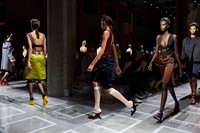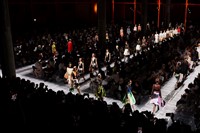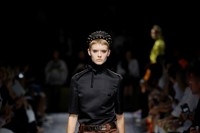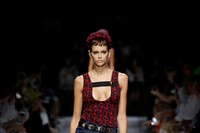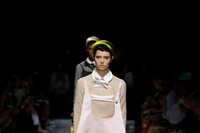Miuccia Prada staged her Spring/Summer 2019 show on the ground floor of the newly built, Rem Koolhaas-designed Torre of the Fondazione Prada; the entire place was outfitted in plastic, with ghostly Verner Panton plastic inflatable stools for the audience to hunch on. The backdrop was verdant chartreuse green. The whole place was slick and glossy, unreal and dreamlike.
Over the summer, the Fondazione played host to an exhibition exploring art under Fascism in interwar Italy, commencing exactly a century ago and including not only original works from the period by Giacomo Balla, Giorgio de Chirico and Giorgio Morandi, but ghostly renderings of items lost or destroyed during political turbulence. Which made me think of those phantasmagoric Panton chairs. The show was subtitled Art Life Politics, and although Prada distinctly divides the Fondazione from fashion, that also serves as a neat summary of what Miuccia Prada was tackling in her show for next spring. Is it facile for me to ally fashion to Fascism? It was Mussolini himself who stated: “Any power whatsoever is destined to fail before fashion. If fashion says skirts are short, you will not succeed in lengthening them, even with the guillotine.”
Miuccia Prada also believes in the power of fashion. Probably because she produces some of the most powerful fashion in the world – and, as she once told me, “a beautiful dress is sometimes better than a bad piece of art”. Backstage – which was actually, really, front of house, just by the Torre exit – she talked about ideas of freedom, liberation, fantasy, of being against conservatism. Later in the evening, at a dinner in the Torre, she recalled how one of her sons chastised her for not using her position to speak about what was wrong in the world. So Prada created a collection embedded with political, social and cultural meaning – poised at the point between liberal idealism and rampant conservatism – exactly where the world is right now. Extreme left, extreme right – Miuccia Prada was, famously, a Communist. Her views remain radical; her clothes are too.
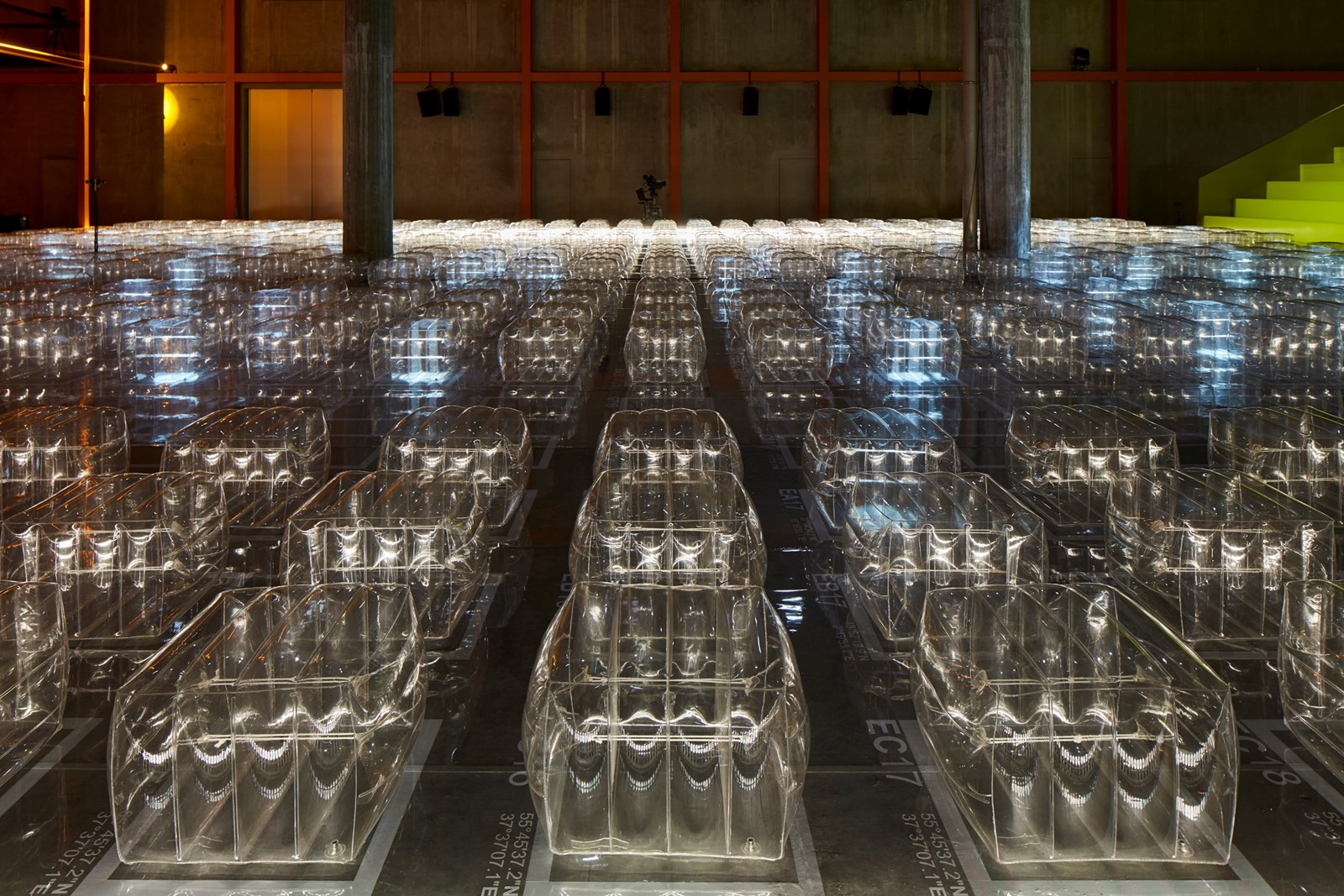
How to express that through clothing? How about a schoolgirl-style shirt and sweater combo with holes sliced open in back, or another pocked with studs and fused with a transparent pleated skirt over big knickers – freeing the crotch, if not the nipple. Conservative shapes made transparent, disparate elements fused together, big bites taken out of garments, prissy little bows oddly pinned to collars or hems. Babydolls were stiff rather than seductive in Prada nylon, the abbreviated mini hems speaking of the liberation, physical and sexual, that the 1960s inextricably coupled with thigh-high hemlines. Everything was twisted, a little off or weird.
Often, Miuccia Prada uses her collection to examine things she loathes (one time, famously, golf; another, lace) and perhaps try to convince herself (and others) that they’re desirable. “I always like to move in that space, never please anybody,” she has told me. “There is always something disturbing, which is probably what I am, and I like.” This collection, paradoxically, felt like an expression of many of the things Miuccia Prada enjoys, or admires. Uniforms, predominantly – before she began making clothes for herself, she used to wear maid’s and schoolgirl’s uniforms, because she hated everything else out there. There were echoes of them here, as well as the uniforms of class and status, those of the bourgeoisie she has explored time and time again. There was also her signature, favoured nylon, and more abstractly the notion of intelligent women. That was expressed through handbags, fittingly enough – Miuccia Prada first made her fashion presence felt with there Prada nylon backpack, a clever bag, for clever women. Here, a trio of major female architects – Cini Boeri, Elizabeth Diller and Kazuyo Sejima – designed bags for the collection, the second step of the ‘Prada Invites’ project first unveiled at the men’s show in January.
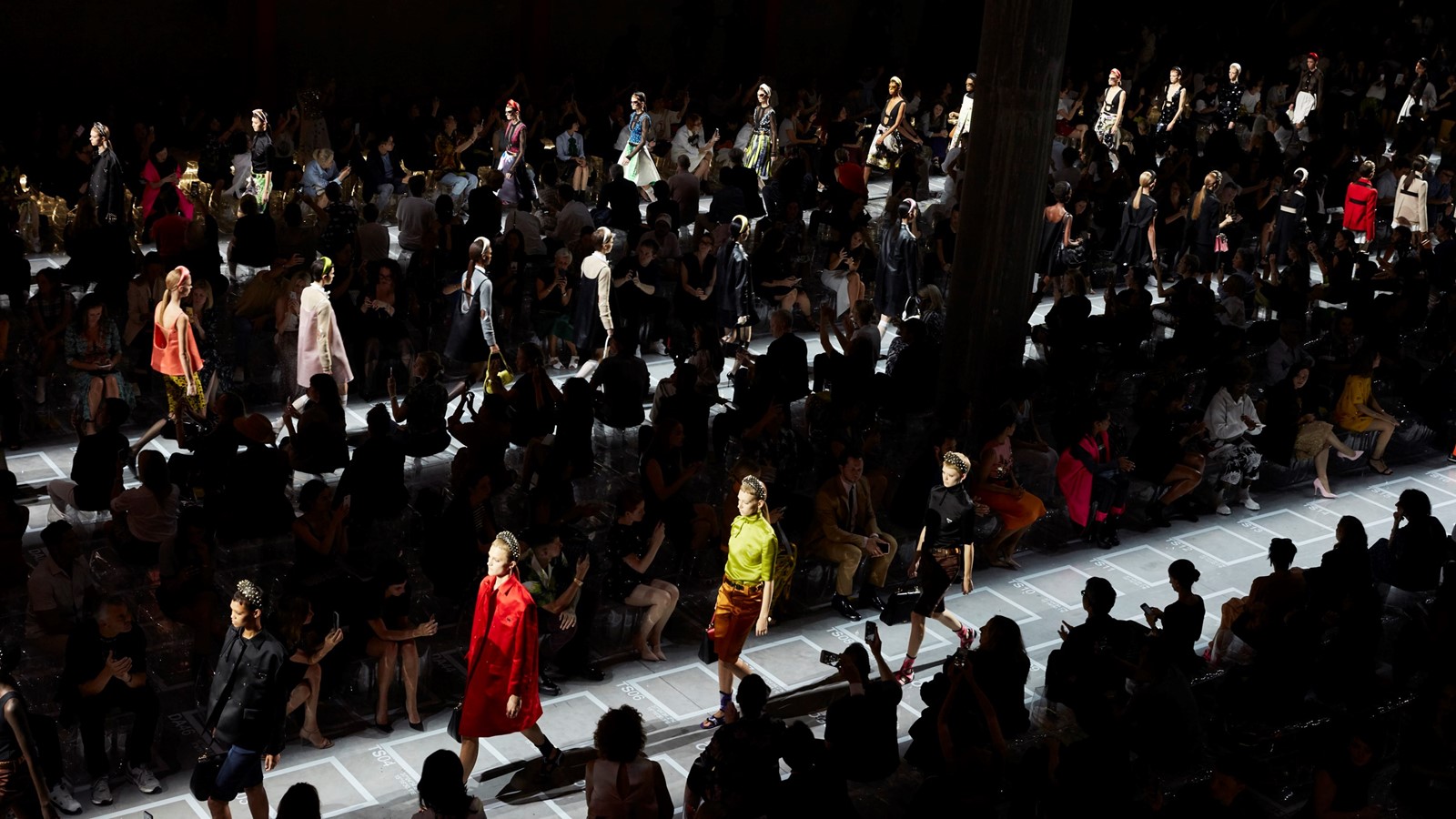
On earliest, initial, visceral reaction, there was something plainly right about this Prada show – something that felt important, significant and memorable. On second reading, while listening to Mrs Prada explain her mood, her ideas, her feeling, and beginning to unpeel the layers of meaning encoded into each garment, it was clear why: this Prada collection achieved that rare, elusive feat of encapsulating the era in which it was created. In its maelstrom of textures, of opposing ideals and ideologies, its refusal to kowtow to homogeny, its constant questioning of convention, it embodied – literally, on the backs of women – the tangled world as we are experiencing it right now. Maybe, in 100 years time, these will be the pieces in another Fondazione, paying testament through reflection to the times in which we are living.

